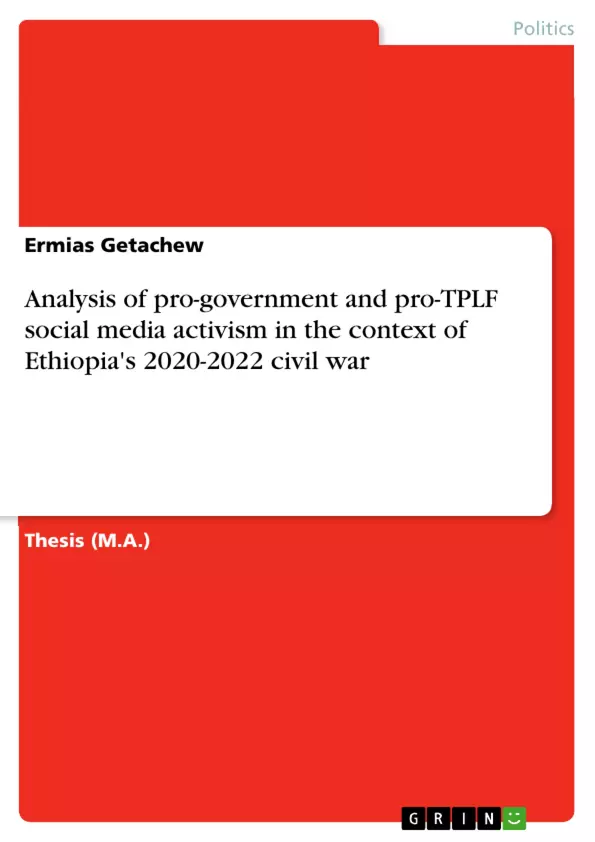This thesis is a comparative content analysis of Pro- government and Pro- TPLF activism during the war and after the signing of the Agreement on Permanent Cessation of Hostilities, also known as the Pretoria Agreement, in the context of the 2020-2022
Ethiopian civil war.
The study argues that unlike the military confrontation in the ground, those Pro-government and Pro-TPLF activists played major role in amplifying and exacerbating the war through the social media warfare. It further argues that the involvement of different actors behind each Pro-government and Pro-TPLF activists makes the technological warfare and weaponization trend of social network more complicated and dangerous to sustained peace. The study concludes based on the findings that greater efforts are needed to ensure new mechanisms to understand the nature, role, and dynamics of social media warfare. Therefore, media literacy work and professional engagement in this field has to be seriously considered.
Inhaltsverzeichnis (Table of Contents)
- CHAPTER ONE
- 1. INTRODUCTION
- 1.1. BACKGROUND OF THE STUDY
- 1.2. STATEMENT OF THE PROBLEM
- 1.3. OBJECTIVE OF THE STUDY
- 1.3.1. GENERAL OBJECTIVE
- 1.3.2. SPECIFIC OBJECTIVES
- 1.4. RESEARCH QUESTIONS
- 1.5. SCOPE OF THE STUDY
- 1.6. SIGNIFICANCE AND IMPLICATION OF THE STUDY
- 1.7. LIMITATION OF THE STUDY
- 1.8. ORGANIZATION OF THE STUDY
- CHAPTER TWO
- 2. REVIEW OF RELATED LITERATURE
- 2.1. CONCEPTUALIZING SOCIAL MEDIA
- 2.1.1. DEFINING SOCIAL MEDIA
- 2.1.2. IMPORTANCE OF SOCIAL MEDIA
- 2.1.3. SOCIAL MEDIA'S ROLE IN WAR AND PEACE
- 2.1.4. NEXUS OF SOCIAL MEDIA AND SOCIAL MOVEMENTS
- 2.2. SOCIAL MEDIA ACTIVISM
- 2.2.1. ACTIVISM DURING WAR AND PEACE
- 2.2.2. ROLE AND IMPACT OF SOCIAL MEDIA ACTIVISM IN WAR
- 2.3. Information manipulation
- 2.3.1. MANIPULATION STRATEGIES
- 2.4. EVOLUTION OF SOCIAL MEDIA ACTIVISM IN ETHIOPIA
- 2.5. THE ROLE OF SOCIAL MEDIA ACTIVISM IN CONTEXT OF ETHIOPIA’S 2020-2022 CIVIL WAR
- 2.6. APPROACHES TO PEACEBUILDING
- 2.7. THEORETICAL FRAMEWORK
- CHAPTER THREE
- 3. RESEARCH DESIGN AND METHODOLOGY
- 3.1. INTRODUCTION
- 3.2. PHILOSOPHICAL FOUNDATION
- 3.3. METHODOLOGY
- 3.4. RESEARCH DESIGN
- 3.5. SAMPLING
- 3.6. DATA SOURCES AND COLLECTION TOOLS
- 3.7. DATA ANALYSIS AND INTERPRETATION
- 3.8. ETHICAL CONSIDERATION
- CHAPTER FOUR
- 4. DATA PRESENTATION, ANALYSIS AND DISCUSSION OF RESULTS
- 4.1. DATA PRESENTATION
- 4.1.1. CONTEXT OF THE CIVIL WAR
- 4.1.2. OPERATIONAL TERMINOLOGIES DURING THE CIVIL WAR
- 4.2. DATA ANALYSIS
- 4.2.1. PARTICIPANTS PROFILE
- 4.2.2. COMMON CHARACTERISTICS OF PRO-GOVERNMENT AND PRO-TPLF ACTIVISTS
- 4.3. FINDINGS
- 4.4. DISCUSSION
- CHAPTER FIVE
- 5. CONCLUSION
Zielsetzung und Themenschwerpunkte (Objectives and Key Themes)
This research conducts a comparative content analysis of pro-government and pro-TPLF social media activism during and after Ethiopia's 2020-2022 civil war. The study aims to understand the role of these activists in amplifying and exacerbating the conflict through social media warfare, and to explore the techniques employed in information manipulation.
- The role of social media activism in shaping public perception of the Ethiopian civil war.
- Comparative analysis of information manipulation techniques used by pro-government and pro-TPLF activists.
- The impact of specific social media platforms on the dynamics of the conflict.
- The contribution (or lack thereof) of social media activism to peacebuilding efforts.
- The influence of external actors on social media activism during the conflict.
Zusammenfassung der Kapitel (Chapter Summaries)
Chapter One: Introduces the study, outlining the background of social media activism in Ethiopia, the problem statement focusing on the understudied role of activists in amplifying the civil war, the research objectives and questions, scope, significance, limitations, and organization of the thesis.
Chapter Two: Reviews relevant literature on social media, its role in war and peace, social media activism, information manipulation techniques, the evolution of social media activism in Ethiopia, and approaches to peacebuilding. A theoretical framework is also presented.
Chapter Three: Details the research design and methodology, including the philosophical foundation (constructivism), methodology (qualitative comparative content analysis), sampling techniques, data sources (primarily Twitter), data analysis methods (thematic content analysis), and ethical considerations.
Chapter Four: Presents data presentation, analysis, and discussion of results. This chapter analyzes the context of the civil war, operational terminologies, participant profiles, common characteristics of activists from both sides, and various information manipulation techniques employed, such as war propaganda, allegations, blame shifting, satire, conspiracy theories, amplification, undermining, warnings, capitalizing on social media trends, targeted harassment, and meme warfare.
Schlüsselwörter (Keywords)
Social media activism, information manipulation, Ethiopia, civil war, TPLF, pro-government, propaganda, disinformation, peacebuilding, comparative content analysis, Twitter, hashtag activism, Connective Action.
- Quote paper
- Ermias Getachew (Author), 2024, Analysis of pro-government and pro-TPLF social media activism in the context of Ethiopia's 2020-2022 civil war, Munich, GRIN Verlag, https://www.grin.com/document/1499927



